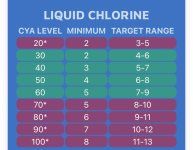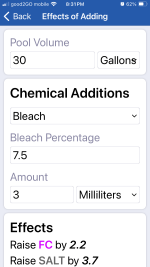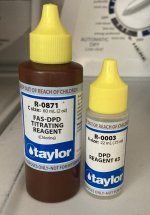[Edit: My wife told me her Dr. said she had a skin ‘sensitivity’ to Bromine, not an ‘allergic reaction’. I have changed my references to ‘allergy/allergic’ to ‘skin sensitivity’. The link says that ‘skin sensitivity’ (irritant contact dermatitis) shows a reaction, rash, in 1–2 hours (which she had), whereas ‘allergic contact dermatitis’ is an immune system reaction that takes from 24 to 48 hours to show symptoms. The ‘skin sensitivity reaction’ was quite severe for her, so it is still a significant issue. This article talks about testing patches of skin on your arm, like a dermatologist would do. I’ll have her ask her Dr. if he/she can recommend a chlorine % solution to apply to her arm as a chlorine sensitivity test, rather than dunking her whole body in a bathtub of chlorinated water!]
Before we go through the hassle of draining the tub and restarting with Chlorine as the sanitizer instead of Bromine, to see if Chlorine causes my wife no skin rashes, we want to fill the bathtub with hot water and simulate the chlorine water conditions that would be the same as if we convert the hot tub to chlorine.
So here are our questions:
1) Is it common for some people to have a skin sensitivity reaction to Bromine, but NOT to Chlorine? What are the odds of this? (I’ll have her ask her Dr. about this too.)
2)How do I create a bathtub chlorine environment to match a hot tub's? [We may hold off for a possible arm skin patch test for chlorine if that is an option.]
a) Would I need to reduce our tap water's 370 ppm TA (Total Alkalinity) down below 70 ppm (our hot tub's current TA is 40 ppm), then get the PH adjusted between 7.4–7.7 before adding Chlorine to make the test valid as close as possible to apples to apples to the actual hot tub?
b) How much of 7.5% chlorine to initially add to, say ≈ 30 gallons of bath water to get an in-range chlorine level?
c) I only have a Taylor K-2106 'Bromine' test kit. Is there a workaround test that will tell me the effective Chlorine level I need to measure? If I can't do that with my K-2106 kit/reagents, what reagents would I need to buy to perform a proper Chlorine level test for our experimental bathtub test?
3) Are people with similar Bromine sensitivity able to completely avoid skin irritant sensitivity reactions of rashes and bumps by simply taking Antihistamines like: 25mg Benadryl or 10mg Cetirizine HCI (Zyrtec or Amazon Generic), 10 mg Loratadine (Claritin or Amazon Generic)? If so, what doses and how long before and after?
The Background:
We purchased a brand-new Bullfrog A6L (310 gals) Hot tub with the only time it was filled was at OEM water test at the time of manufacture, three months prior. The tub was purged, water balanced, Bromine Reserve added, Chlorine Shock done, PH & Bromine levels have been kept in range. It causes my wife extreme rash and bumps, but I have no skin reactions at all. Our initial soak (103º F, PH 7.6, Ttl Bromine 6ppm, TA 30 ppm) caused her an extreme skin irritation reaction where she had a rash and bumps on her trunk, arms and legs. I am using a Taylor K-2106 'Complete (FAS-DPD bromine)' test kit.
She said the pain and itching for a week was worse than her prior bout of Covid. It kept her awake all night. A week and a half later we let the Total Bromine drop to zero, PH ≈7.6, TA 40ppm. The water temp was only at 93º F. The skin irritation reaction was nowhere near as strong, but she still felt it coming on 1–2 hours after her soak. She took one Zyrtec 10mg Cetirizine HCI Antihistamine at that time and for two days following and the rash dissipated. I have had no skin irritation reactions at all.
Installation, thorough Purge and refill process:
Three weeks ago, after the brand new hot tub was installed, I filled it (310 gals) and did a purge using AHH!some. Ran jets on high w/ air for 30 mins. wiped away the green sludge from the shell above the water line and scooped a few small patches from the water. I then removed the four Bullfrog JetPaks and cleaned the green from them that was at the waterline. As an extra precaution, I then ran the jets on high for a second 30 minute period. There was only a small amount of green residue to wipe away this time. I then hosed ≈ 50 gallons of water into the tub via each jet to rinse any lingering residue of green biofilm and AHH!some purge. I siphoned out then used a shop vac to completely drain the foot well as well as vacuuming each JetPak supply pipe and all the lowest fixed jets. I have rinsed the filter once per week. I am pretty sure we can rule out ‘hot tub folliculitis’.
Thanks in advance for sharing what you did to be able for the allergic person to be able to enjoy the hot tub.
Dave
Before we go through the hassle of draining the tub and restarting with Chlorine as the sanitizer instead of Bromine, to see if Chlorine causes my wife no skin rashes, we want to fill the bathtub with hot water and simulate the chlorine water conditions that would be the same as if we convert the hot tub to chlorine.
So here are our questions:
1) Is it common for some people to have a skin sensitivity reaction to Bromine, but NOT to Chlorine? What are the odds of this? (I’ll have her ask her Dr. about this too.)
2)How do I create a bathtub chlorine environment to match a hot tub's? [We may hold off for a possible arm skin patch test for chlorine if that is an option.]
a) Would I need to reduce our tap water's 370 ppm TA (Total Alkalinity) down below 70 ppm (our hot tub's current TA is 40 ppm), then get the PH adjusted between 7.4–7.7 before adding Chlorine to make the test valid as close as possible to apples to apples to the actual hot tub?
b) How much of 7.5% chlorine to initially add to, say ≈ 30 gallons of bath water to get an in-range chlorine level?
c) I only have a Taylor K-2106 'Bromine' test kit. Is there a workaround test that will tell me the effective Chlorine level I need to measure? If I can't do that with my K-2106 kit/reagents, what reagents would I need to buy to perform a proper Chlorine level test for our experimental bathtub test?
3) Are people with similar Bromine sensitivity able to completely avoid skin irritant sensitivity reactions of rashes and bumps by simply taking Antihistamines like: 25mg Benadryl or 10mg Cetirizine HCI (Zyrtec or Amazon Generic), 10 mg Loratadine (Claritin or Amazon Generic)? If so, what doses and how long before and after?
The Background:
We purchased a brand-new Bullfrog A6L (310 gals) Hot tub with the only time it was filled was at OEM water test at the time of manufacture, three months prior. The tub was purged, water balanced, Bromine Reserve added, Chlorine Shock done, PH & Bromine levels have been kept in range. It causes my wife extreme rash and bumps, but I have no skin reactions at all. Our initial soak (103º F, PH 7.6, Ttl Bromine 6ppm, TA 30 ppm) caused her an extreme skin irritation reaction where she had a rash and bumps on her trunk, arms and legs. I am using a Taylor K-2106 'Complete (FAS-DPD bromine)' test kit.
She said the pain and itching for a week was worse than her prior bout of Covid. It kept her awake all night. A week and a half later we let the Total Bromine drop to zero, PH ≈7.6, TA 40ppm. The water temp was only at 93º F. The skin irritation reaction was nowhere near as strong, but she still felt it coming on 1–2 hours after her soak. She took one Zyrtec 10mg Cetirizine HCI Antihistamine at that time and for two days following and the rash dissipated. I have had no skin irritation reactions at all.
Installation, thorough Purge and refill process:
Three weeks ago, after the brand new hot tub was installed, I filled it (310 gals) and did a purge using AHH!some. Ran jets on high w/ air for 30 mins. wiped away the green sludge from the shell above the water line and scooped a few small patches from the water. I then removed the four Bullfrog JetPaks and cleaned the green from them that was at the waterline. As an extra precaution, I then ran the jets on high for a second 30 minute period. There was only a small amount of green residue to wipe away this time. I then hosed ≈ 50 gallons of water into the tub via each jet to rinse any lingering residue of green biofilm and AHH!some purge. I siphoned out then used a shop vac to completely drain the foot well as well as vacuuming each JetPak supply pipe and all the lowest fixed jets. I have rinsed the filter once per week. I am pretty sure we can rule out ‘hot tub folliculitis’.
Thanks in advance for sharing what you did to be able for the allergic person to be able to enjoy the hot tub.
Dave
Last edited:




